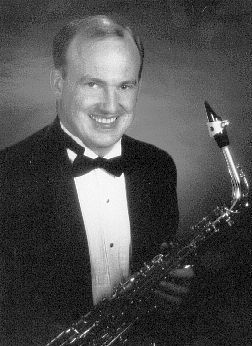|
(U.S.A.)
|
 |
||||
|
|||||
Objective: Inform audience of the performance possibilities and increasing need to teach double and triple tonguing on the saxophone.
OutlineHistory
Demonstration
Teaching
Final solo demonstrationHandouts
Currently I am Assistant Professor of Saxophone at Indiana University of Pennsylvania. I recently retired as Principal and Solo Saxophonist with The USAF Band in Washington DC after 20 years of performing with that organization. One of the things I learned early in my career was the need to double tongue. Other members of my section were using this technique very successfully and accomplishing the challenging literature with much greater ease than I. Since learning this technique, I have incorporated it into solo literature as well as ensemble performance. Although many saxophonists do not use multiple tonguing, there has been a recent surge in learning this technique and I believe in the next l0 years most saxophonists will utilize it as brass and flute performers have for years. |
|||||
| Keith R. Young is Assistant Professor of Music at Indiana University of Pennsylvania where he teaches saxophone performance studies and directs the IUP Jazz Band. He recently retired as the principal saxophonist with the U.S. Air Force Band in Washington, D.C. Since 1978 he performed with that ensemble on saxophone and piano with The Concert Band, Saxophone Quartet, Orchestra and Dixieland Band, touring throughout the United States, Canada, Germany, England, France, Italy, Japan, Russia, and the Peoples Republic of China.
As saxophone soloist, Dr. Young has performed on international tours with the U.S. Air Force Band and as guest soloist with college and high school bands. Solo performances have included the 1986 International Bandmasters and Orchestra Directors Conference in Chicago; the 9th and 10th World Saxophone Congresses in Japan and Italy; the 1988 Music Educators National Conference; the 1989 American Bandmasters Association Convention; Virginia, Maryland, and South Carolina Music Educators Conferences; with the U.S. Navy Band at their 1991, 1995, and 1997 International Saxophone Symposium; the 1998 American School Band Directors Association: and the 1998 North American Saxophone Alliance Biennial Conference. Dr. Young received a bachelor in music education from Bowling Green State University in Ohio, a master in music performance from the Catholic University of America, and a doctorate in musical arts degree from the University of Maryland. He has also done graduate work at the University of Cincinnati and studied in Bordeaux, France, with world-renowned saxophonist Jean-Marie Londeix. Other saxophone instructors have included Dale Underwood, Reginald Jackson, Louis Marini, Sr., and jazz saxophonist, Chris Vadala. In addition to his duties with The U.S. Air Force Band, Dr. Young was adjunct saxophone instructor at Virginia Commonwealth University from 1981 to 1987 and also served two terms as secretary for the North American Saxophone Alliance. |
|||||
|